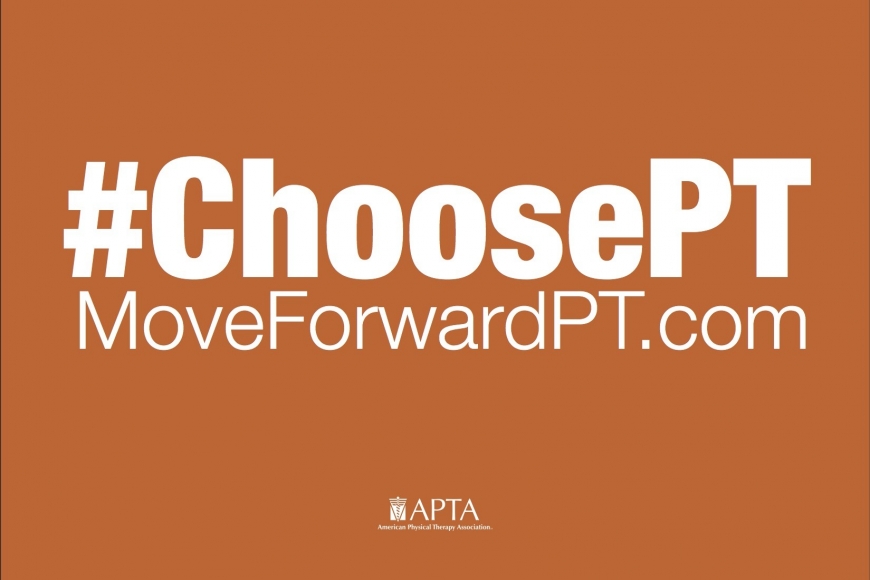#ChoosePT for Pain Management

With National Physical Therapy month just a couple of weeks away, I thought it would be an opportune time to highlight the American Physical Therapy Association (APTA) #ChoosePT campaign. This campaign is a response to the national opioid epidemic and strives to educate both consumers and providers on the potential risks of prescription opioids and to encourage safer alternatives for pain management, such as physical therapy.
A rise in opioid prescriptions began in the 1990s in response to health organizations, such as the American Pain Society, pushing to improve standards for pain management. Pain became the “fifth vital sign” in hospitals and a major focal point of treatment (1). Pharmaceutical companies took advantage of this new focus to market pain-relieving medications, including opioids. A critical upshift in opioid prescriptions occurred in 1995 when the FDA approved OxyContin. This opioid was strongly marketed to physicians with the labeling falsely claiming that the risks for addiction and abuse were low (2). The sale of prescription painkillers increased by 300% between 1999 and 2011, and by 2012 the rate of opioid prescriptions had peaked at 81.3 prescriptions per 100 persons (3). Death rates from overdosing on prescription painkillers also rose, and in 2016, over 42,000 people died from an opioid overdose (4).
In response to this rising epidemic, the Centers for Disease Control and Prevention (CDC) published updated guidelines in 2016 for prescribing opioids for chronic pain. The guidelines were determined by synthesizing clinical evidence, contextual factors (benefits/harms, financial impacts, resource allocations), and expert opinions. For determining when to initiate or continue opioid use, the guidelines state, “Nonpharmacologic therapy and nonopioid pharmacologic therapy are preferred for chronic pain. Clinicians should consider opioid therapy only if expected benefits for both pain and function are anticipated to outweigh risks to the patient. If opioids are used, they should be combined with nonpharmacologic therapy and nonopioid pharmacologic therapy, as appropriate.” (5)
Physical Therapy as an alternative to opiods
Physical therapy is one of the preferred nonpharmacologic therapies as an alternative or adjunct to opioids. Research has supported the effectiveness of exercise for reducing pain and improving function in chronic pain syndromes, such as fibromyalgia, and common musculoskeletal conditions such as low back pain, hip, and knee arthritis (6-9). Physical therapists also employ manual techniques to address soft tissue, myofascial, or joint restrictions that could be contributing to pain. As movement specialists, we are also uniquely qualified to assess how movement patterns, postures, repetitive activities, poor ergonomics, etc. may be leading to pain. Thus, physical therapy can reduce pain symptoms while also addressing the underlying issue.
To be clear, this post and the #ChoosePT campaign is not a condemnation of opioids. There are certainly cases where they are indicated and there are people who only experience pain relief with the help of an opioid prescription. The goal of the #ChoosePT campaign is to spread awareness that there are other pain management options out there, such as physical therapy, that can be just as effective as opioids and carry less risk. Whether someone is in acute or chronic pain, the management of that pain should be an individualized approach, that is a collaboration between the patient and their healthcare providers. Therefore, as a patient, know your options and that physical therapy is one of them!
For more information about the#ChoosePT campaign, visit the APTA's Move Forward webpage.
Works Cited
- Busch, Aj, et al. “Exercise for Treating Fibromyalgia Syndrome.” The Cochrane Database of Systematic Reviews (Protocol), 2002.
- Campbell, James N. “APS 1995 Presidential Address.” Pain Forum, no. 1, 1996.
- Dowell, Deborah, et al. “CDC Guideline for Prescribing Opioids for Chronic Pain — United States, 2016.” MMWR. Recommendations and Reports, no. 1, 2016.
- Fransen, Marlene, et al. “Exercise for Osteoarthritis of the Hip.” Cochrane Database of Systematic Reviews, 2014.
- Fransen, Marlene, et al. “Exercise for Osteoarthritis of the Knee.” Cochrane Database of Systematic Reviews, 2015.
- Hayden, Jill, et al. “Exercise Therapy for Treatment of Non-Specific Low Back Pain.” Cochrane Database of Systematic Reviews, 2005.
- Opioid Overdose. 31 July 2017, www.cdc.gov/drugoverdose/maps/rxrate-maps.html. Accessed 16 Sept. 2018.
- Seth, Puja, et al. “Overdose Deaths Involving Opioids, Cocaine, and Psychostimulants — United States, 2015–2016.” MMWR. Morbidity and Mortality Weekly Report, no. 12, 2018.
- Zee, Art Van. “The Promotion and Marketing of OxyContin: Commercial Triumph, Public Health Tragedy.” American Journal of Public Health, no. 2, 2009.


